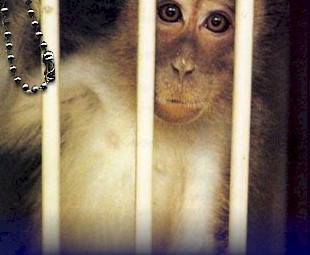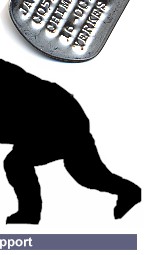






|
||||||||||||||||||||||||||||||||||||||||||||||||||||||||||||||||||||||||||||||||||||||||||||||||||||||||||||||||||||||||||||||||||||||||||||||||||||||||||||||||||||||||||||||||||||||||||||||||||||||||||||||||||||||||||||||||||||||||||||||||||||||
Yerkes National Primate Research Center 1997 NIH Base Grant: $5,662,807
Second, Yerkes specializes in forcibly addicting monkeys to illegal drugs. And third, Yerkes funds studies which prove that chimpanzees and bonobos are capable of communicating with humans with human language and possess a sensitivity and consciousness so like our own that empathic understanding is common between members of each species (human and non-) who are given the time to get to know each other; while at the same time, Yerkes intentionally infects them with malaria and HIV-1 and forces them to live in solitary confinement. Living Links Primate vivisectors are unable to make ethical decisions based on their own findings: intense public scrutiny and involvement is warranted. Our silence, in light of current knowledge regarding the minds of monkeys and apes, is akin to the German people's silence during the Holocaust. This is illustrated by Yerkes's Living Links Center. The Center's introduction states “...our institute conducts all of its work with noninvasive techniques that we would not hesitate to apply to human volunteers. Our goals are 1) to reconstruct human evolution, 2) pinpoint the differences and similarities between humans and apes, and 3) educate the public about apes, and promote their well-being and conservation.” The goals are admirable and a casual observer would not easily discern that the Center was a part of Yerkes. It is a macabre looking-glass world. At Yerkes, researchers work to understand the minds and emotions of monkeys and apes and have published papers and books that point out remarkable similarities, and differences, between the species, humans included. But the very people who know who these animals are, simultaneously remain mute concerning the suffering of the animals in the disease and cocaine labs. Perhaps they whisper together after work or even speak openly among themselves, but they do not speak publicly. Imagine a Southern slave owner operating a college for the study of African intelligence, there really is very little difference; whites used to view all persons of color as inferior; persons with mental and physical handicap were relegated to the basements and circuses for much of history. Now, we simply carry on the tradition. Just as people wonder why more Germans did not speak out, so too will our children wonder about us. Shielded from Public View Yerkes uses the fact that its host university, Emory University, is a private college to shield it from public scrutiny. Yerkes has repeatedly refused to provide a census of the monkeys and apes it has on hand to members of the public. Yerkes claims that, being a private institution, they need not answer inquires from the public, that they are exempt from the federal Freedom of Information Act and that the many millions of dollars in taxpayer support they receive does not come with a responsibility to the taxpayer. As long as Congress agrees, the concerns of the pubic regarding the facility are of no merit. Animal Care Yerkes, precisely like every other facility in the nation experimenting on animals, claims that all the animals under its control are well cared for by experts in their fields. They claim, on their website, that:
A look at what actually goes on in the Yerkes labs will make short shrift of the notion that the animals at Yerkes are “well cared for.” “Comparative Behavioral Pharmacology of Cocaine and the Selective Dopamine Uptake Inhibitor RTI-113 in the Squirrel Monkey” was published in the journal Pharmacology and Experimental Theraputics [Vol. 292, Issue 2, 521-529, February 2000]. The authors are Leonard L. Howell, Paul W. Czoty, Michael J. Kuhar and F. Ivy Carrol. All the authors, except F. Ivy Carol, are Yerkes/Emory University scientists. In their paper, the researchers are quite clear regarding what they did to the monkeys they used in their experiments. They explain this in the "Materials and Methods" section of their paper.
There are a couple of points that should be called to the reader's attention regarding this passage. 1. The squirrel monkeys were housed individually. Squirrel monkeys naturally live in large social groups. This is common knowledge. Consider the Emory University Policy on Environmental Enrichment for Nonhuman Primates (Revised April, 2001).
One could suppose that the nine monkeys with the surgically implanted chronically indwelling venous catheters for i.v. administration of drugs might be monkeys exempted by the above statement concerning compatibility with ongoing research protocols. Maybe other monkeys would attempt to pull the tubes from their necks and thighs. But the point of placing the monkeys in the nylon mesh jackets is exactly to block access to the tubes. If a monkey was unable to access the catheter in his neck or thigh due to the protective jacket, it remains to be seen how a cage mate might be able to do so. The Emory University Policy on Environmental Enrichment for Nonhuman Primates (Revised April, 2001) states:
It remains to be seen why these monkeys were not afforded even "protected contact." And what of the other seven monkeys? The paper is not clear regarding the way they were used and mentions nothing concerning their housing. 2. "All animal-use procedures were in strict accordance with the National Institutes of Health Guide for the Care and Use of Laboratory Animals and were approved by the Institutional Animal Care and Use Committee at Emory University." It needs to be stated and stated again: no oversight body -- neither the U.S. Department of Agriculture, through the Animal and Plant Health Inspection Service, nor the National Institutes of Health, and certainly not the researcher-staffed Institutional Animal Care and Use Committee at Emory University -- saw anything wrong, from an ethical or moral perspective, with this experiment. What was done to the monkeys was just fine. 3. It must be inferred that the monkeys were considered to be "materials." Returning to the paper:
Let's try to put this in understandable terms -- without all the pseudoscientific gibberish the Yerkes scientists have dressed it in: The monkeys were trapped in a chair-like restraint device inside a plastic box. The notion that they were seated comfortably is a subjective bit of conscience-salving self-protection by the scientists. Their tail was shaved and clamped between two metal plates so that the monkeys could be shocked. A light in front of them came on and they had three seconds to pull a lever to keep from being shocked. Then, one of three different drugs was injected through the tube that had been sewn into their body, and the light came on again. This was repeated thirteen times a day for five days a week. (The researchers rested over the weekend.) The point of all of this was to see how much of the drug it took for the monkey to not be able to press the lever in time to avoid the shock. This is what's termed Science by Yerkes. This is how animals are "well cared for" at Yerkes. Cocaine is a cash-cow for Yerkes. Similar experiment have been on-going at Yerkes for a long time. In fact, the restraint device -- the chair in the plastic box -- was designed by a Yerkes cocaine researcher name Larry Byrd whom the researchers above cite when describing the restraint apparatus: Byrd L. D. (1979) The behavioral effects of cocaine: Rate dependency or rate constancy. European Journal of Pharmacology 56: 355-362. As if this cruel nonsense were not enough to impel citizens to force the closure of this modern Auswitz, consider a few of the other experiment occurring there: A. A. Anasari <pathaaa@emory.edu> was studying the differences of SIV progression in two species of monkeys. He noted no difference in disease progression. He received $317,552 for this study. He has moved on to cocaine and SIV; he is studying the effects of cocaine exposure on the vasculature of monkeys infected with SIV. James T. Winslow <jwinslow@rmy.emory.edu> states, “[We] will examine the interaction of decreased central serotonin with the effects of acute alcohol administration, the incidence of excessive alcohol self-administration in a free-choice ethanol self-administration paradigm . . .[in] juvenile [rhesus] monkeys reared in peer groups with mother reared monkeys who are either intact or have been depleted of brain serotonin following administration of neurotoxic doses of MDMA.” Winslow is affiliated with Living Links. Francis J. Novembre <fnovembr@rmy.emory.edu> seems to feel that referring to chimpanzees by their serial number rather than by their name will make his Mengele-like experiments sound scientific and less criminal. He reported: "At the time that C499 developed illness, blood was transfused from this animal to an uninfected animal, C455, to further examine the pathogenesis of virus infection." Novembre was avoiding saying that before Jerom (C499 ) died, he was paralyzed with a drug so that some of his blood could be taken. Then his blood was forcibly injected into Nathan (C455) to see if he would also become hideously sick and die in a similar manner. Liars or Ignoramuses? And, Yerkes simply lies. Or, maybe only ignoramuses work there. In either event, they repeatedly make false statements. From the Yerkes website:
Some national animal rights organizations do, in fact, support and operate sanctuaries. In Defense of Animals operates Project Hope in Mississippi. Approximately one hundred and fifty dogs, cats, horses, pigs, chickens, and other animals have found refuge there. Black Beauty Ranch, run by the Fund for Animals is a fourteen hundred acre haven for rescued animals. Many sanctuaries, such as Farm Sanctuary, are operated by people who do see themselves as activists. Why doesn't Yerkes know of these facilities? Are they just lying, or simply ignoramuses? But maybe Yerkes, due to its focus on primates, is unaware of what is occurring in the animal activist community regarding cows, horses, sheep, dogs, cats, and animals other than monkeys and apes. But then, why don't they know that the Animal Protection Institute operates the Texas Snow Monkey Sanctuary? Why don't they know that the International Primate Protection League operates a gibbon sanctuary in South Carolina? Why don't they know that In Defense of Animals operates a chimpanzee rescue center in Cameroon, Africa? Maybe they do know about these facilities. Maybe Yerkes is simply so used to lying to the public about what it is accomplishing and about what they really do to animals in the labs, that lying about those who are criticizing their behavior comes as naturally to them as addicting baby monkeys to cocaine and alcohol. Also from the Yerkes website:
No oversight body -- neither the U.S. Department of Agriculture, through the Animal and Plant Health Inspection Service, nor the National Institutes of Health, nor the American Association for the Accreditation of Laboratory Animals Care (claimed to be the "gold standard" for humane and sanitary lab animal care by the labs themselves) and certainly not the researcher-staffed Institutional Animal Care and Use Committee at Emory University sees anything wrong, from an ethical or moral perspective, with the experiments at Yerkes. What is being done to the monkeys and chimpanzees is just fine. A Citizenry of Fools? And finally, Yerkes says: "Interestingly, the guidelines for conducting research on animals are considerably more stringent than those for research on humans." This presupposes that either those reading this garbage have absolutely no idea what is happening inside Yerkes, or else, that those reading this garbage are so stupid that they will actually believe that the rules allowing scientists to strap monkeys into chairs inside plastic boxes and shock them repeatedly are more stringent than the rules protecting human research subjects. For the record: Yerkes is not an anomaly. Yerkes is the norm. It is the average primate lab. The only thing that keeps these monstrosities in operation is your silence.
Home Page | Our Mission | News |
